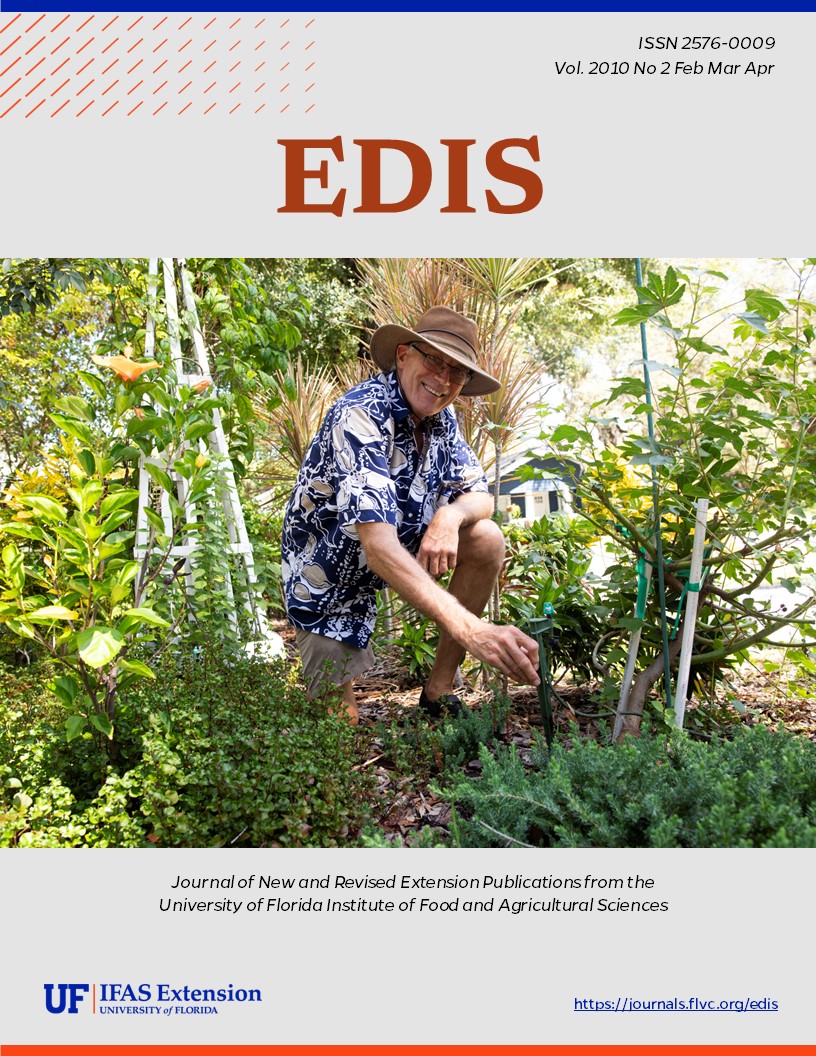Abstract
SL-305, a 5-page illustrated fact sheet by Cory J. Krediet, Kim Ritchie, and Max Teplitski, addresses some questions regarding coral reef biology, coral reef health, and the ecological and economic benefits coral reefs provide. Includes references. Published by the UF Department of Soil and Water Sciences, August 2009.
References
Bellwood, D. R., T. P. Hughes, C. Folke, and M. Nystrom. 2004. Confronting the coral reef crisis. Nature 429:827-833. https://doi.org/10.1038/nature02691
Bhat, M. G. 2003. Application of non-market valuation to the Florida Keys marine reserve management. Journal of Environmental Management 67:315-325. https://doi.org/10.1016/S0301-4797(02)00207-4
United States Department of Commerce. 1995. Florida Keys National Marine Sanctuary Draft management plan/environmental impact statement, vol. II. Page 245 in N. O. A. A. Administration.
Costanza, R., R. dArge, R. deGroot, S. Farber, M. Grasso, B. Hannon, K. Limburg, S. Naeem, R. V. ONeill, J. Paruelo, R. G. Raskin, P. Sutton, and M. van den Belt. 1997. The value of the world's ecosystem services and natural capital. Nature 387:253-260. https://doi.org/10.1038/387253a0
Dunn, S. R., C. E. Schnitzler, and V. M. Weis. 2007. Apoptosis and autophagy as mechanisms of dinoflagellate symbiont release during cnidarian bleaching: every which way you lose. Proceedings of the Royal Society B-Biological Sciences 274:3079-3085. https://doi.org/10.1098/rspb.2007.0711
Edmunds, P. J. 2007. Evidence for a decadal-scale decline in the growth rates of juvenile scleractinian corals. Marine Ecology-Progress Series 341:1-13. https://doi.org/10.3354/meps341001
Fabricius, K. E. 2005. Effects of terrestrial runoff on the ecology of corals and coral reefs: review and synthesis. Marine Pollution Bulletin 50:125-146. https://doi.org/10.1016/j.marpolbul.2004.11.028
Fung, I. Y., S. C. Doney, K. Lindsay, and J. John. 2005. Evolution of carbon sinks in a changing climate. Proc Natl Acad Sci U S A 102:11201-11206. https://doi.org/10.1073/pnas.0504949102
Harvell, C. D., K. Kim, J. M. Burkholder, R. R. Colwell, P. R. Epstein, D. J. Grimes, E. E. Hofmann, E. K. Lipp, A. D. Osterhaus, R. M. Overstreet, J. W. Porter, G. W. Smith, and G. R. Vasta. 1999. Emerging marine diseases--climate links and anthropogenic factors. Science 285:1505-1510. https://doi.org/10.1126/science.285.5433.1505
Hoegh-Guldberg, O. 1999. Climate change, coral bleaching and the future of the world's coral reefs. Marine and Freshwater Research 50:839-866. https://doi.org/10.1071/MF99078
Howarth, R., D. Anderson, J. Cloern, C. Elfring, C. Hopkinson, B. Lapointe, N. Malone, K. McGlathery, A. Sharpley, and D. Walker. 2000. Nutrient pollution of coastal rivers, bays, and seas. Issues Ecol 7:1-15.
Johns, G. M., V. R. Leeworthy, F. W. Bell, M. A. Bonn, F. S. U. a. N. in association with Hazen and Sawyer Environmental Engineers and Scientists, and G. P. Yang. 2001. Socioeconomic study of reefs in southeast Florida. Page 348 in P. B. C. Broward County, Miami-Dade County, Monroe County, Florida Fish and Wildlife Conservation Commission, National Oceanic and Atmospheric Administration, editor. Hazen and Sawyer, PC.
Krediet, C. J., K. B. Ritchie, M. Cohen, E. K. Lipp, K. P. Sutherland, and M. Teplitski. 2009. Utilization of mucus from the coral Acropora palmata by the pathogen Serratia marcescens and by environmental and coral commensal bacteria. Appl Environ Microbiol 75:3851-3858. https://doi.org/10.1128/AEM.00457-09
Lapointe, B. E., P. J. Barile, and W. R. Matzie. 2004. Anthropogenic nutrient enrichment of seagrass and coral reef communities in the Lower Florida Keys: discrimination of local versus regional nitrogen sources. Journal of Experimental Marine Biology and Ecology 308:23-58. https://doi.org/10.1016/j.jembe.2004.01.019
Lipp, E. K., J. L. Jarrell, D. W. Griffin, J. Lukasik, J. Jacukiewicz, and J. B. Rose. 2002. Preliminary evidence for human fecal contamination in corals of the Florida Keys, USA. Mar Pollut Bull 44:666-670. https://doi.org/10.1016/S0025-326X(01)00332-0
Park, T., J. M. Bowker, and V. R. Leeworthy. 2002. Valuing snorkeling visits to the Florida Keys with stated and revealed preference models. Journal of Environmental Management 65:301-312. https://doi.org/10.1006/jema.2002.0552
Rosenberg, E., O. Koren, L. Reshef, R. Efrony, and I. Zilber-Rosenberg. 2007. The role of microorganisms in coral health, disease and evolution. Nat Rev Microbiol 5:355-362. https://doi.org/10.1038/nrmicro1635
Szmant, A. 2002. Nutrient enrichment on coral reefs: Is it a major cause of coral reef decline? Estuaries and Coasts 25:743-766. https://doi.org/10.1007/BF02804903
Teplitski, M. and K. B. Ritchie. 2009. How feasible is the biological control of coral diseases? Trends Ecol Evol 24:378-385 https://doi.org/10.1016/j.tree.2009.02.008
Weil, E., G. Smith, and D. L. Gil-Agudelo. 2006. Status and progress in coral reef disease research. Dis Aquat Organ 69:1-7. https://doi.org/10.3354/dao069001

